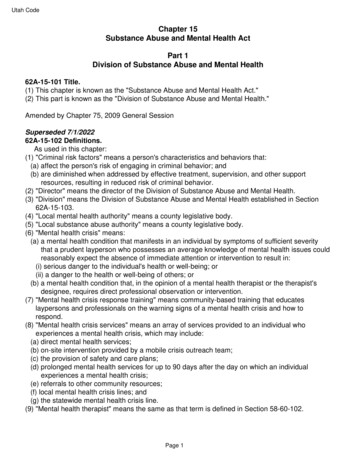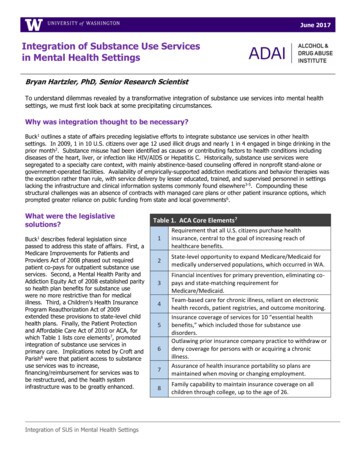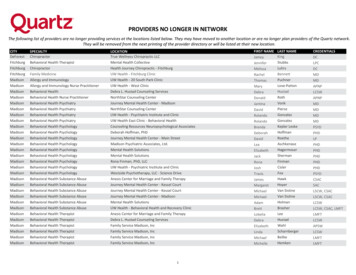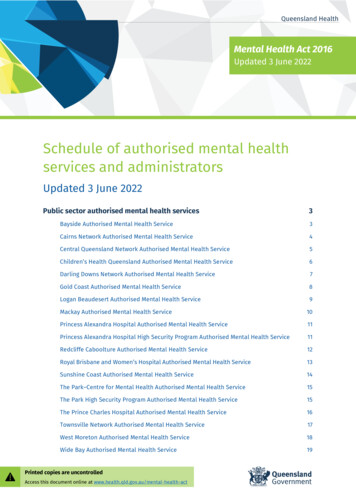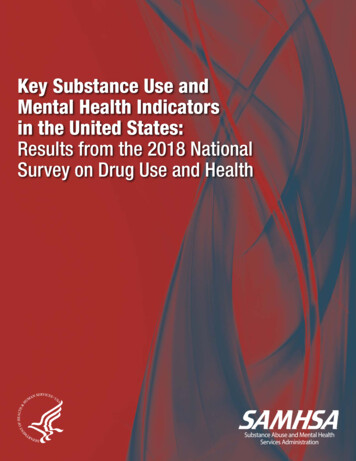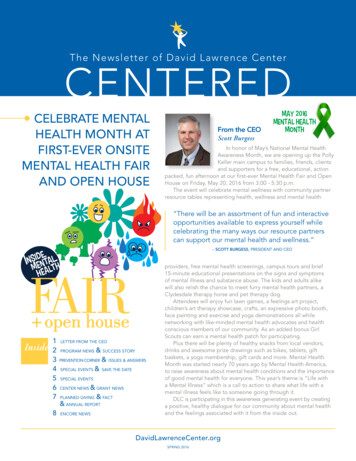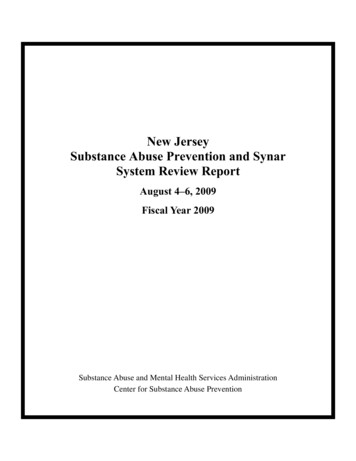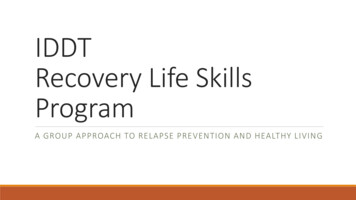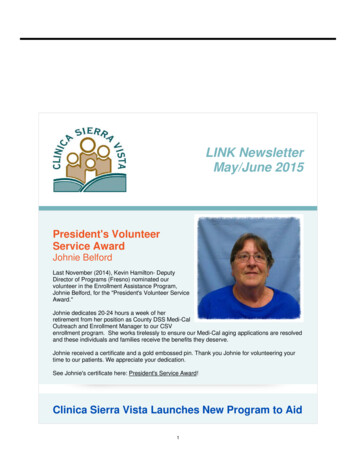
Transcription
Community Mental Health andSubstance Abuse AssessmentExecutive SummaryPurpose of the AssessmentIn 2016, partners from across the community came together to assess the health needs of theSpringfield region and collectively address those needs. One issue that emerged, both as a priorityhealth issue and as a contributing factor for other prioritized health issues, was mental health. Thedata used to prioritize mental health was limited—but it was a topic of great concern among careproviders, public health and healthcare partners, media and the community. Springfield and GreeneCounty leaders knew mental health and the often-connected issue of substance abuse needed to beaddressed. But with little understanding of underlying causes, the breadth of these issues in thecommunity, or how to best address concerns, the path forward was unclear. An assessment of theseissues in our community was necessary to determine a path toward improvement.Although both mental illness and substance abuse can occur independently of one another, they aretwo issues that are often co-occurring. For this reason, this assessment studies both conditions, theirimpact on one another, and the effects for broader community.In 2017, The Missouri Foundation for Health awarded the Springfield-Greene County HealthDepartment a 252,500 grant for a comprehensive study and action plan for mental health andsubstance abuse in Greene County. Crescendo Consulting Group was selected as the consultant tobring outside expertise, perspective, and guidance to the project.Leadership and guidance were provided by Healthy Living Alliance (HLA), a local group of leaders thathave organized around making healthy living a priority in Greene County by bringing togetherrepresentatives from local business, government, nonprofit, and healthcare industries. The HLAAdvisory Council provided direction and feedback to Crescendo as they worked to collect informationfrom various stakeholders throughout the community. Using the information Crescendo gathered,assembled, analyzed and reported, the members of HLA completed a validated process to arrive at aset of prioritized mental health needs.This executive summary provides a glimpse of the methods used, findings of the report, and proposedactions. More detailed information of the assessment can be found in the full report atwww.sgfmentalhealth.orgAssessment Process and Community EngagementThe project included both qualitative and quantitative research methods including provider dataanalysis and community data. Together, this research was used to identify key domains, categories foraction, and a prioritized set of interventions to address mental health and substance abuse-relatedneeds in Greene County.April 2019www.sgfmentalhealth.org1
Provider Data AnalysisPrimary data was collected directly from mental health and healthcare service providers and otherstakeholders and offered an in-depth understanding of mental health and substance abuse specific tothe demand in our community on the local system. Service use data was collected from partners BurrellBehavioral Health, CoxHealth, Jordan Valley Community Health Center, and Mercy Springfield.Community DataThe community’s commitment to mental health, as well as momentum toward improvement, allowedthe project to identify needs, ideas, and strategies. It also served to inform service providers ofsynergistic efforts in the community, created collaboration between organizations, identified duplicativeinitiatives, and raised awareness of mental health and substance abuse needs.Feedback from the community came from: 200 people as part of 18 focus groups,62 one-on-one interviews from individuals representing more than 50 service organizationsadditional feedback and support from broader community presentationsThe assessment also utilized secondary data through the development of an environmental scan. Anenvironmental scan is a process that systematically looks at publicly available data, existing research,and other information that helps describe the area. This included U.S. census data, the number ofdoctors in the area, the percentage of people with certain health conditions, and muchmore. Environment scan data helps to define some of the higher-level information about an area, butdoes not include more in-depth insight gained through group discussions, individual interviews, andother means of learning about a community.Key FindingsAs a result of this process, HLA decided upon three domains and one common thread. The domainswere developed to categorize findings to create an organized set of information. This helps to betterunderstand aspects of mental health and substance abuse and to develop strategies that will addressassociated challenges.April 2019www.sgfmentalhealth.org2
StigmaStigma is the result of a personal feeling of shame, embarrassment, failure, or judgment around mentalhealth or substance abuse. Stigma can be powerful enough to prevent people from seeking supportand care. Stigma affects all sectors; education, health, criminal justice, workforce and many others.Seven of ten (69.7%) stakeholders interviewed through this assessment said that stigma-related issuesare among the most important needs. One in three young adults, age 18 – 35, who needed mentalhealth care chose not to receive it due to perceived stigma or discrimination.1Domain 1: Awareness and Early InterventionAwareness and early intervention includes community awareness, insight, and perceptions regardingmental health and substance abuse. Solid schools, a capable workforce and a strong economy are thelifeblood of a strong community. The lack of awareness of mental illness and substance abuse, as wellas understanding of early intervention options and community resources, impact these importantsectors.In Our CommunityThe report also helps capture the impact of mental health and substance abuse on workforce. InGreene County, more than 30% of interview respondents identified that mental illness and substanceabuse as a leading issue affecting workforce. In the 2019 Momentum workforce survey, employersindicated concern with mental health (65%) and substance abuse (69%).Momentum Workforce SurveyAmount of ConcernIssue1A LotSomeNoneSubstance abuse (e.g., opioids, alcohol, etc.)24%45%31%Mental health15%50%35%SAMHSA, 2015April 2019www.sgfmentalhealth.org3
According to the Missouri Student Survey, an estimated 2,300 middle and high school students inSpringfield Public Schools have seriously considered suicide in 2018.Missouri Student SurveyMeasure2018 Greene County2018 MissouriSeriously considered suicide18.2%14.1%Planned suicide12.5%10.9%Attempted suicide6.7%6.2%What is NeededIncreasing community understanding of mental health and substance abuse, as well as encouragingpeople to get the treatment and support they need can make a significant impact. Training andeducation tools, such as Mental Health First Aid and Youth Mental Health First Aid can provide solidknowledge, empathy and interventions that connect people suffering from mental illness or substanceabuse to resources that will prevent conditions and suffering from worsening. This can lead to improvedoutcomes and reduce morbidity and mortality.Efforts to improve awareness and early intervention should improvesupport to employers, promote education, and create practical tools.Domain 2: Crisis StabilizationThe Substance Abuse and Mental Health ServicesAdministration defines crisis stabilization as “a directservice that assists with deescalating the severity of aperson's level of distress and/or need for urgent careassociated with a substance use or mental healthdisorder. The primary goal of crisis services is tostabilize and improve psychological symptoms ofdistress and to engage individuals in an appropriatetreatment service to address the problem that led tothe crisis.”2In Our CommunityIn Greene County, over half of the stakeholdersagreed that crisis services are among the mostimportant needs. This is due to several reasons, buttwo especially stood out: suicides increase without access to crisis resources and people who strugglewith substance abuse are at elevated risk of overdose if they unsuccessfully seek services.2As found in 0for%2C%20Crisis%20Services%206-5-14 8.pdfApril 2019www.sgfmentalhealth.org4
SuicideAcross the country, throughout the state of Missouri and in the Springfield-Greene County area, therate of suicide has increased significantly from 2008 to 2017. Rates in Greene County have increasedand are consistently higher than the U.S. and Missouri, increasing 71% from 2008-2017. Startlingly,suicide rates for men in Greene County are 221% greater than that for women3. Data suggests that90% of those who die by suicide exhibited symptoms of a mental illness or substance abuse4.Furthermore, research shows that greater availability of mental health and substance abuse serviceshas a protective effect against suicide5.Substance Use DisordersMissourians have alsosuffered from the opioid crisisand have seen increases inoverdose-related deaths overthe past several years. InGreene County, drug induced deaths haveincreased year over year from2013-2015 and continue torise. Treatment for drugrelated diagnoses inemergency departments andinpatient settings hasincreased from 2014 to 2016. Addiction treatment services are often costly and underfunded byinsurance coverage, creating barriers for access and, therefore, likely increasing risk of crisis.3US Centers for Medicare and Medicaid Management (CMS). Available at Data Source: Centers for Medicare and MedicaidServices. 2015. Source geography: County4Isometsa ET. (2001). Psychological autopsy studies—a review. can Psychiatric Association. de-preventionApril 2019www.sgfmentalhealth.org5
Depression and AnxietyIn Greene County, mood disorders, which includes depression, are the most common diagnosiscategory for serious mental illness at publicly-funded facilities. Over 30,000 people in Greene County—more than 10% of the population—sought help for mental health and/or substance use disorders in2017. Depression rates in Greene County are 36.7% higher than the U.S. average6.Medicare recipients in Greene County also suffer from a slightly higher rate of depression than the stateaverage and national average. Higher rates of depression in Greene County are also consistent withthe findings in provider data, which shows that major depressive disorder is the primary cause ofinpatient stays and the secondary cause of outpatient visits for a mental health diagnosis in healthcaresettings. Mental health diagnoses that lead to an inpatient admission in healthcare settings in GreeneCounty are driven by depression and anxiety in more than half of those admissions. Similarly, 64.5% ofmental health outpatient diagnoses are due to depression and anxiety.6US Centers for Medicare and Medicaid Management (CMS). Available at Data Source: Centers for Medicare and MedicaidServices. 2015. Source geography: CountyApril 2019www.sgfmentalhealth.org6
April 2019www.sgfmentalhealth.org7
Efforts to improve crisis stabilization should develop system supports,provide direct services, and strengthen policy and procedure.April 2019www.sgfmentalhealth.org8
Domain 3: Access to Appropriate CareThis domain includes capacity and the availability of direct serviceproviders, care coordination, and other system-level supports thatfacilitate efficient access to the health care system. This domain isconcerned with people getting the right care, at the right time, in theright place.In Our CommunityAccess to care is the first step in receiving quality health care. Thisincludes having health insurance, having a usual source of care, andreceiving care when needed. In Greene County, 15% of adults do nothave health insurance, which affects access to health care.Regarding access to mental health services, nearly 80% of interviewrespondent’s that participated in this assessment identified the needfor greater access to care. This did include expressing issues withlong waiting periods to see a provider, a lack of mental healthprovider sites, uncertainty about how to access the healthcaresystem, and transportation challenges.What is NeededThe community has a shortage of capacity; there are insufficient providers and hospital beds to provideadequate cover for mental health and substance abuse. According to the Missouri Department ofHealth and Senior Services, there is a shortage of inpatient psychiatric beds within the community, with37.8 beds per 100,000 people, well below the national benchmark of 507. While Springfield has ahigher rate of overall mental health providers than the national average, there are several mitigatingfactors. Springfield serves as a regional hub, providing access to a far greater number of people thanjust those living in Greene County.Springfield also lacks adequatepsychiatrists—with 6.2psychiatrists per 100,000, it isbarely above the 10th percentileand is well short of the nationalaverage of 10.9 psychiatrists per100,000. A commonly identifiedbarrier and possible solution toincreasing access to mentalhealth care and addictiontreatment documented throughoutthe assessment was addressingreimbursement inadequacies.Efforts to address access to appropriate care should increase capacity,strengthen system supports, and improve policy and regs/pdf/MOhospbyCounty.pdfApril 2019www.sgfmentalhealth.org9
Psychiatrists per 100,000 ResidentsRegionApril 2019Data PointSpringfield, MO6.2National Average10.990th Percentile14.850th Percentile8.510th Percentile5.5www.sgfmentalhealth.org10
Community Improvement EffortsThroughout this assessment, community providers have taken action to address concerns of mentalhealth and substance abuse. Below are some of the actions that have been part of building solutions.CoxHealthBurrell Behavioral HealthMercy Hospital CoxHealth isproviding PDMPLeadership at thelocal and statelevels. Increased access to mental healthcare. Specifically, efforts at Burrellhave led to increased access tothe walk in clinic and decreasedwait time for appointments. Behavioral healthunit in EmergencyDepartment hasbeen created forpsychiatric patients. The number of“psych safe” bedshas doubled fromfour to eight. The partnership with theSpringfield Public Schools systemincludes offering counselingservices in schools. Addiction treatmentservices have beenexpanded byestablishing a newpartnership withHazeldine BettyFord Clinic. Expanded PD Virtual mobile clinicservices is planned. Initiatives to reduceopioid use in painmanagementprograms isunderway. There has been afocus on increasedtraining andprotection forhealthcareworkforce.CoxHealth will bedeveloping plans towork with MissouriHospitalAssociation andothers on efforts toenhance workforcesafety initiatives.April 2019 Embedded access in primary carepractices and EmergencyDepartments is underway. Forexample, Burrell is currentlypartnering with CoxHealth andMercy Hospital to offer mentalhealth access inside the hospitals’Emergency Departments in anongoing effort to integratebehavioral health in primary care. There are expanded services atthe JVCHC Integrated Clinic. Forexample, there is a clinic on thenorth side of Springfield serving asa partner clinic between JordanValley Community Health Centerand Burrell Behavioral Health. Access to mentalhealth servicesthroughtelemedicine—especially inpediatrics – isincreasing. Partnership withBurrell has beenestablished toprovide mentalhealth servicesseamlessly throughthe EmergencyDepartment. Thepartnership alsoincludes psychiatrycoverage for the IPpsychiatric unit.Jordan ValleyCommunity HealthCenter ACES screening isbeginning to takeplace in the clinicalcare environment. Community HealthWorkers areincreasingly beingused to increasesystem capacity. MedicationAssistance TherapyClinic currentlyoperates five daysper week (Monday –Friday). Integrated, clinicbased care activitieswith BurrellIntegrated Clinichave beenexpanded. An addictionprogram for pregnantmothers isexpanding. Certified Community BehavioralHealth Clinics (CCBHC) expansioncontinues to be an active goal ofFederal and State advocacy(Burrell is currently one of only tenCCBHCs in Missouri and the onlyone in the Springfield area).www.sgfmentalhealth.org11
Opportunities for ImprovementAs a result of this report, the community is armed with knowledge and information needed to effectivelyaddress mental health needs and take ownership of efforts to reduce stigma, increase awareness, andimprove access to mental health services.To implement these interventions and more, community partners must collaborate and mobilizeresources to carry out evidence-based strategies and/or innovative solutions. Because mental healthand substance abuse affect multiple sectors to varying degrees, it is important that leaders from diversefields lead efforts to address these needs within their respective fields of work.ReimbursementAssuring that adequate reimbursement for treatment of mental illness is available for substance abuseand mental health providers alike was identified by all providers and other interviewees through theassessment. The rate of reimbursement is not sustainable for adequately meeting demand for mentalillness.Specifically, items stated include: Addiction treatment services are often reimbursed at rates lower than the cost of care, or notcovered by insurance.Medicaid:o The lack of expansion impacts uncompensated care in all settings.o There is a need for Medicaid suspension v. termination upon incarceration in Missouri.Access to Appropriate CareEmergency Departments are often the place where patients seek care for mental illness, especially incrisis situations. Identifying symptoms and preventing crises can offer diversion to other moreappropriate care. Additionally, efforts to prevent and reduce the suicide rate in Greene County shouldbe a priority.Resources and ToolsMental Health First Aid Training was identified as a valuable resource and necessary tool to be used tooffer early intervention and prevention of crisis. Currently, Community Partnership of the Ozarks isoffering training and education to reduce the incidence of mental illness and prevent crises. Theseefforts and others should be leveraged and should be used to train our community, specifically children,youth and young adults, some of our most vulnerable.Provider ShortagesMental Health provider shortages are prevalent in Springfield but also throughout the country. Efforts toseek options for alternative ways to treat patients such as telehealth and community health workersmust be explored to expand care.April 2019www.sgfmentalhealth.org12
The report also helps capture the impact of mental health and substance abuse on workforce. In Greene County, more than 30% of interview respondents identified that mental illness and substance abuse as a leading issue affecting workforce. In the 2019 Momentum workforce survey, employers indicated concern with mental health (65%) and substance .
